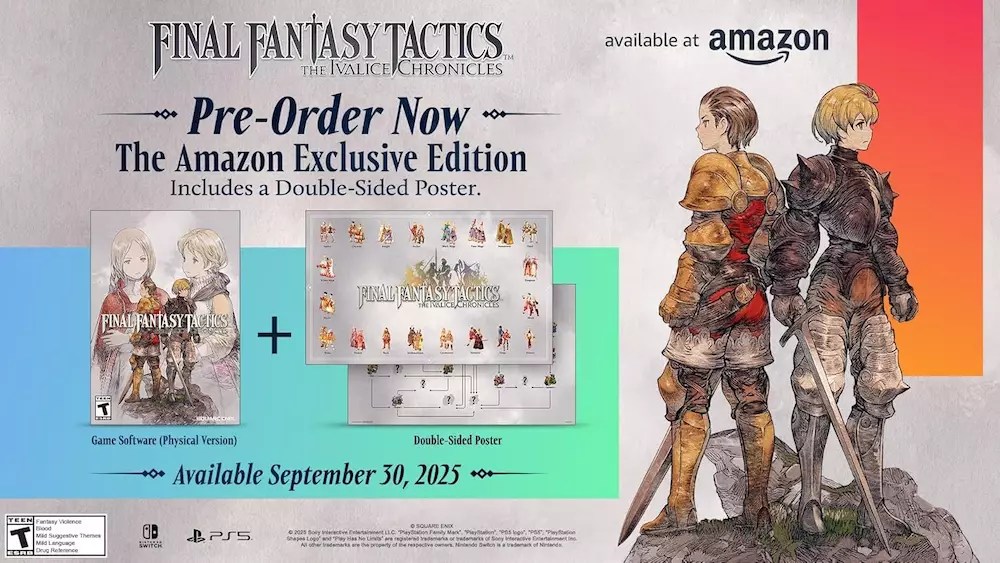Square Enix’s recent announcement regarding the upcoming release of Final Fantasy Tactics: The Ivalice Chronicles for Nintendo Switch and PS5 is a calculated masterstroke in modern gaming strategy. The fact that the Switch 2, anticipated to elevate the gaming experience with enhanced performance, will feature a free visual and frame rate upgrade signifies a forward-thinking approach that prioritizes consumer value. This move not only reassures dedicated fans about their investment but also underlines the company’s recognition of the importance of backward compatibility and seamless upgrade paths in current gaming ecosystems.
While the upgrade is available for pre-order on the eShop, intriguing questions arise about the company’s hardware strategy. Notably, Square Enix’s decision not to release a physical edition compatible with Switch 2 hints at a larger trend of companies shifting away from physical media for newer platforms, perhaps due to supply chain challenges or a focus on digital markets. For consumers, this creates a dual reality: digital upgrades are prioritized, yet the tangible scarcity of physical editions on newer hardware may diminish the overall collector’s appeal and tradability that classic game fans cherish.
Furthermore, this approach subtly influences the collector’s mentality. The exclusive Amazon Edition, featuring a thoughtful, character-art poster and in-game bonuses, caters to a niche of die-hard collectors craving tangible keepsakes. Yet, with concerns about limited stock and eventual sellouts, it illustrates the current tension between digital convenience and the longing for physical memorabilia—a tension that could redefine how games’ collectible value is perceived in the future.
The Collector’s Box: A Testament to Legacy and Luxury
The Collector’s Box release, priced at a hefty $200, exemplifies a premium treatment that appeals to fans eager to own a piece of game history. The inclusion of intricately designed collectibles like the Ramza figure, plush Chocobos, an outlying church diorama, and exclusive art prints demonstrates an awareness that the game’s legacy is intertwined with tangible art and memorabilia. It transforms a simple gaming purchase into an experience—an immersive descent into Ivalice’s rich universe.
These physical items are not merely tokens; they echo the game’s historical importance, blending nostalgia with artistry. The pop-up diorama, for example, offers a faithful reimagining of a pivotal location, blending craftsmanship with fandom. This kind of packaging elevates the collector’s edition beyond standard fare, positioning it as a statement piece rather than just a game product. Yet, the glaring reality is that such lavish editions are ephemeral. The initial sellout reflects high demand, but it also underscores the exclusivity that often drives the secondary market and inflated resell prices—a phenomenon that can alienate casual fans or newcomers who missed the preorder window.
From a broader perspective, the high price point and limited availability reinforce a growing trend: gaming companies are increasingly turning lucrative collectibles into luxury items, shifting some focus away from pure gameplay and story to lifestyle and status symbols. This trend is not inherently negative; it caters to the aspirational aspect of gaming and allows fans to express their devotion tangibly. However, it risks commodifying legacy titles, turning cherished classics into high-end collectibles reserved mainly for the affluent.
The Digital-Physical Divide in Modern Gaming Releases
While the physical editions and the Collector’s Box cater to enthusiasts, the broader release strategy emphasizes digital convenience. The game’s availability across platforms like Steam, Xbox Series X|S, and PS4, alongside Nintendo Switch and PS5, illustrates a universal approach to maximizing reach. Yet, the choice to restrict physical editions to certain consoles reveals a pragmatic limitation—likely driven by manufacturing costs, licensing, or market demand.
This division between digital and physical, especially in a beloved franchise like Final Fantasy Tactics, raises questions about the erosion of traditional gaming rituals. Collecting physical copies, flipping through game manuals, and displaying collectible art have historically fostered a sense of ownership and community. The departure from this norm, accelerated by the scarcity of physical editions for certain platforms, risks creating a fragmented fan experience—where ownership becomes more transient and less personal.
Moreover, the exclusive bonuses offered by Amazon, such as the character art poster and job class flowchart, highlight how retailers now leverage physical extras to entice consumers, blurring the lines between traditional game content and merchandising. As game publishers continue to navigate this landscape, the challenge will be balancing monetization with honoring the legacy of classic titles without commodifying them excessively.
The Enduring Legacy of Final Fantasy Tactics and Its Market Evolution
Final Fantasy Tactics, originating in a different era, now finds itself at the crossroads of nostalgia and modern marketing. The remaster and re-release serve as a testament to its enduring appeal, yet they also reflect the industry’s shift toward leveraging nostalgic properties for lucrative remakes, deluxe editions, and merchandise.
The introduction of a $250 bundle containing the Collector’s Box and the game itself signals a push towards premiumization of classic titles. While undoubtedly attractive for dedicated fans, such high-priced offerings may inadvertently restrict access to a broader audience. The fact that the Collector’s Box quickly sold out indicates a robust, dedicated community that values tangible artifacts of their gaming passion. However, this exclusivity raises concerns: does this trend risk marginalizing fans who prefer affordable or purely digital experiences?
Furthermore, the addition of in-game items—gear, weapons, and consumables—serves to deepen player engagement but subtly reinforces the gamification of nostalgia. While these bonuses enhance the gaming experience, they also symbolize how modern marketing increasingly intertwines physical collectibles, digital content, and proprietary in-game assets into a unified ecosystem designed to maximize revenue streams.
Ultimately, Square Enix’s approach signifies a nuanced strategy: provide multiple avenues for engagement—from mass-market digital releases to premium physical collectibles—while subtly capitalizing on the game’s legendary status. As the franchise evolves, so too does its interaction with fans and collectors, shaping a complex marketplace where history, innovation, and marketing collide.


Leave a Reply